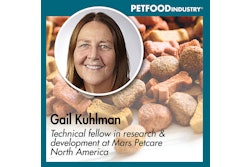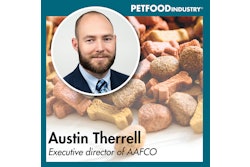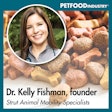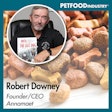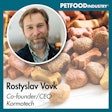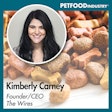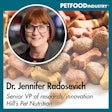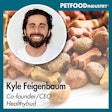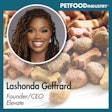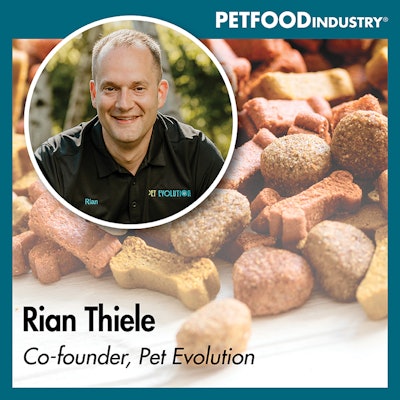
I spoke with Rian Thiele, Co-founder and CEO of Pet Evolution, and we dove deep into the modern-day pet retailer/pet customer relationship. If you're a brand wondering how to improve your relationship with your retail partners, or a retailer looking to optimize your relationships with your customers, this is the episode for you!
The below transcript is from Episode 39 of the Trending: Pet Food podcast, where I spoke with the Co-founder and CEO of Pet Evolution Rian Thiele about the modern relationship between pet customers and the retailers they frequent. You can find the episode at www.PetfoodIndustry.com/trending-pet-food-podcast, on SoundCloud or on your favorite podcast platform. This episode originally aired on July 12, 2023.
(We want to thank AFB international for sponsoring this podcast. AFB is the premier supplier of palatants to pet food companies worldwide, offering off-the-shelf and custom solutions that make pet food, treats and supplements taste great.)
Lindsay Beaton – Editor, Petfood Industry magazine and Host, Trending: Pet Food podcast Hello, and welcome to Trending: Pet Food, the industry podcast where we cover all the latest hot topics and trends in pet food. I’m your host and editor of Petfood Industry magazine Lindsay Beaton, and I’m here today with Rian Thiele, co-founder and CEO of Pet Evolution. Hi, Rian, and welcome!
Rian Thiele – Co-founder and CEO of Pet Evolution
Hi Lindsay, thank you so much for having me on your show.
Beaton: Rian has had a passion for dogs since childhood. Having watched his dogs suffer through itchy paws, chronic ear infections and undiagnosed food allergies, he knew there had to be another way. He and his longtime friend Mike Osborn worked for years to make their dream a reality. They built a store that helps pets live the good life through healthy food, expert services and helpful education. With four stores open and many more on the horizon, Rian is excited to see Pet Evolution span the United States.
Pet Evolution is a locally owned, healthy pet supply store dedicated to providing the highest-quality food, treats, grooming, self-wash and mobile nail trims. Pet Evolution’s mission is simple: Help pets live a good life — through nutrition, through grooming and most importantly through interactions with pet owners.
Rian’s business model for Pet Evolution and his unique perspective is why I brought him on today to answer this question: What does the modern pet customer/retailer relationship look like?
Thiele: You know, that's a great question Lindsay. And for Pet Evolution, let me give you an example: Here's how we look at our customers, for example, as customers from a television show like Cheers, for example. So the relationship that we have with our consumers, our one-on-one relationships where every customer that comes to our doors, we get to know their names, we get to know their pets’ names, we get to know where they went on vacation on a previous weekend. And customers aren't just a number at Pet Evolution, they are family, they don't get ignored. They walk through the doors right away, our staff are there. “Hi, how's it going, Jim?” We call them by name. And it just really helps with having that one-on-one interaction with customers where they feel valued, they feel they're not just a number.
Beaton: Now I know that pet retail is not how you started your career, and that it came out of an idea that you and a friend had. And I want to give the audience an idea of what your thought process was and how Pet Evolution, well, evolved I guess, and how you wanted to make it different from other pet specialty stores.
Thiele: So, I had two dogs growing up, both West White Highland Terriers. They both had really bad allergies growing up and back then, you know, when we would go into the vet clinic, for example, food was the number one question that a veterinarian would normally ask, like, what kind of food are you feeding. So I remember specifically being in the vet clinic, when we fed a particular line of food and the vet had said, “You know what, that food that you're feeding maybe is not the best thing to feed, so let me recommend something else.” So he recommended a different food for my dogs in particular, and the food just never really seemed to work. My dogs would scratch themselves, roll around in the yard, they even got to the point to where they were nibbling at their paws and actually even tearing some skin and fur off of their legs. So, it got really bad. And growing up, I realized that nutrition is really a key aspect to really look at, you know, for pets, just like humans, where it's like the better we eat the longer, healthier lives, we're gonna live, and pets really are the same way.
So I always had a passion for pets. I always had a passion for animals. I also always had a passion for giving back to the community, and my initial career path was law enforcement. And as a police officer, I realized that it wasn't for me anymore — and I loved every day I clocked in; I loved it. But I was like, “You know what, I want to start a business,” and I wanted to have that business be focused on only the best-quality pet foods, the best-quality treats, toys, services. So ultimately, my business partner Mike and I got together and we talked about, “Well, how can we make this happen? What does that mean?” In 2012, we started attending seminars and just trying to figure out like, what is a good-quality product that pets can [eat to] live long, happy, healthy lives? And we learned quickly that it really came down to the ingredient panel on a bag of pet food. And what does that mean? Well, we learned that foods free of corn, free of wheat, free of soy, byproducts, artificial flavors and colors was an area to really focus in on, and that's what we did. So we developed relationships with food manufacturers and distribution companies throughout the Twin Cities here in Minnesota where we started and we narrowed in on those specific line items.
So, in 2012 when we opened up our doors, that's all we focused on. So if none of our foods met those specific standards, we got rid of them. They weren't allowed in our store. So, Lindsay, what really changed our focus, what really highlighted like, oh my gosh, this stuff really does work, was listening to the results of the customers that came through our doors, that would come back for more, more and more. “You know what you guys this product, this food, this treat, this toy, it really changed my dog's life.” And they gave specific reasons and examples of how that happened. An example I have is dogs with allergies would come in, and “My dog's ears are itchy,” or “My dog has hot spots.” Examples would be, “You know, that limited ingredient food that you guys recommended changed my dog's life; I never have to give it the prescription medications again that I used to give to my dogs.” It was just so fun hearing those stories. And not only allergies-related, because if you look at dogs, cats, like humans, we’ll also have customers come in and say, “My pet is overweight. What do you recommend?” Not only do we have foods free of corn, wheat, soy, byproducts, and artificial flavors and colors, but we also have foods that are specifically formulated for weight management issues that pets may have. We have foods that are for senior pets, we have the fish-based foods. So customers that might come in and say, “You know what, my dog or cat has really dry skin. What do you recommend?” Well, we can help out with that as well.
In addition to our raw food products, Lindsay, so we have frozen raw pet food for both cats and dogs as well that we have in our freezers that are great. In fact, the results that you see: Less shedding, shinier coats, less plaque and tartar buildup on the teeth from that enzyme in the meat, just really helps break down that plaque and tartar. And then because it's higher protein, again, you'll see more muscle mass and less fat, which is nice as well. So when it comes down to Pet Evolution, the nutritional aspect of Pet Evolution, we will never fall below the standards that we set back in 2012. And in fact, we've had a number of large manufacturers that have tried repeatedly to have a footprint in our stores. We've always said no, we know if it doesn't meet our brand or ingredients requirements, we do not carry those products.
Beaton: I always enjoy talking to retailers because you have such a unique place in the relationship chain of pet food. There's the pet food brands, there's the pet food consumers, and then there's you, and your relationship with the industry is such that you need to have a relationship with the brands that you have in your store so that you can appropriately educate your customers and so you know what you're selling — and obviously, that is a main focus point for Pet Evolution — and then you also build these relationships with customers, especially as a specialty store where people are coming in and they expect the workers in your store to have some kind of knowledge of what they're selling. So when you were first starting, how did you build those relationships with brands? And then what do those relationships look like now? How have they evolved over the years so that you can stay on top of trends so that you can continue to understand what it is you're selling in your store? And in an age where consumers really want to know the stories behind brands, how do you navigate that, as well?
Thiele: That's a great question, Lindsay. When we first started our relationships with those specific brands, it was a little bit challenging at first, because although we had foods that fell within our specific categories I spoke earlier about, we didn't always see results of what consumers were looking for. Since 2012, we've been able to really navigate the brands and navigate what works and what doesn't by simply listening to the customers. For example, when we first opened, we had five 16-feet rows of retail. Since we opened, we've been able to cut that in half because we learned what really works and what doesn't. And if we don't hear positive results, we don't carry a specific product. So when we first started the brand relationships were really important to work closely with the vendors and really become educated on that product.
And what's great about our vendor reps that we have is they're always willing to come in, help educate the staff, provide training and materials, both online education and in-person education. And that's one of the great things with our food products at Pet Evolution is that every single one of our manufacturer reps are there to help educate and promote their products. This is a mutual relationship between Pet Evolution stores and the manufacturer reps themselves. The evolution of Pet Evolution is we've been able to specifically narrow in on all of the food brands since day one, and I can tell you we went through quite a few brands in particular; we've cut our selection nearly in half. And that's what customers really like about Pet Evolution as they get to know the backstory of what it is that got us to the point that we're at today. And it's really, it's the customers have gotten us to that point, it’s the feedback and the results-driven approach that we have in all of our products here at Pet Evolution.
And I can tell you, Lindsay, the most important thing out of everything is the staff education, because that's one of the key differentiators of our stores. If we don't know the selling points of our products with our consumers and we're not educated, that product is not going to just sell itself. But not only that, that's what we pride ourselves in is really having staff that can be there to answer your questions, to be educated on the products and to help that customer feel that their needs are not only being met, but exceeded with the results that they see.
Beaton: Let's talk about your store layout for a minute. Because in addition to ensuring that your employees are educated about the brands, you try to set up your stores in an intuitive way towards not looking for a specific brand, but looking for a specific solution. Is that correct?
Thiele: Yeah. So, when you first walk into our stores, what you're going to see is our self-service dog wash. So right when you walk through that door, that's going to be right in front of your eyes. Self-serve dog washes, generally four to six, self-service customers will come into the store and wash their dogs. We provide everything from the towels to dryers to shampoo. And then next you'll see the grooming salon. And that's where people that don't want to do the dog wash themselves, or they want a full haircut for their pets, we can do that as well in our grooming salon. So, as you walk through those service areas, then you're going to see treats, you're going to see those bully sticks, those pig ears, limited ingredient treats, you're going to see those toys that the pets absolutely love. And then as you progress, I always like to refer to the food as milk at the grocery store, right, so you kind of have to walk through the whole store until you get to the food.
So then you get to the food selection area and we have all of our foods separated by brand. So by brand of food and then, within those specific brands that's where you'll find the weight management, the senior food, the all-life-stages food, the limited ingredient foods as well within those areas. And again, since we like to promote the small companies, we like to work with the small food companies for example that don't mass produce their foods in all the big box stores throughout the country, and that's what we really focus in on as well in addition to the food being free of all those items, such as corn, wheat, soybeans, byproducts. When you walk into a Pet Evolution, a customer for the first time, it's kind of like walking into a Whole Foods for the first time, right, so when you're walking through the aisles you're going to say, “Ooh, I don't really recognize that brand of food.” And Lindsay, I can remember my first time walking into a Whole Foods I was looking for Doritos, and Whole Foods does not have Doritos, right? So it's very similar to Pet Evolution. So you walk into a Pet Evolution store, you're not going to certainly recognize these brands. And that's why our team is there to help educate on each particular product and the benefits of each item.
Beaton: The relationship between pet owners and their pet food has really evolved. Over the last several years, we've been talking about the fact that they want the story behind the brands. But not only that, the way that they shop for the pet food, the way they research the pet food and really what they want the pet food to do has changed. It used to be, I want my pet to have some food, it should be nutritionally complete, I want them to be healthy, that’s solid. Now, more pet owners than ever are looking for exactly what you provide: They're looking for solutions, whether they're preventive, whether they have a specific issue they're trying to solve — skin and coat, gastrointestinal — there are a million different ways that customers are looking at pet food to solve whatever problems their pets might have. In an era where there are online options, in-store options, a million different functional ingredients and formulas, how do you cultivate a solid relationship with your customers based on, I assume, trust and knowledge and legitimacy when there are so many places they could go and so many references they could be reaching out to?
Thiele: This is great. So you know, Lindsay, the key word is really “trust,” what you had mentioned. Here's the thing, is the pet industry has evolved pretty drastically over these last 15–20 years. I can remember growing up where a lot of times dogs were just tied to a tree outside, fed the cheapest food that you could find at the grocery store. And what's happened over time is the evolution of the pet industry has really changed. I think a lot of that has to do with people making healthier decisions themselves. When you think of pet nutrition and you think of human nutrition, really does kind of go hand-in-hand. So I think as we progress, as we evolve through the times, our pets are family. And people are starting to really see that, you know, they no longer are tied to the tree outside, we have fences. We no longer have dog beds, the dog bed is our own beds. And that's really what's changing in the pet industry, is these guys are children. And at Pet Evolution again, that's what we really pride ourselves on when we're educating our customers, our staff. Like, what does that mean? What differentiates our foods? And that's when we're adding again, more meat content, right, so higher amounts of protein in our foods, more fruits and vegetables in the foods, no fillers.
So if you're looking at an ingredient panel, and a lot of times if you're shopping at like a big box store you'll see ingredient panels that start with corn, or maybe it's byproducts or whatever that looks like, but all of our foods will start out with a whole meat in it, will have fruits and vegetables. Our ultimate mission at Pet Evolution has always been, again, helping pets live a good life. And we do that through proper nutrition, through proper grooming services, and Pet Evolution is a one-stop shop. And that's what we really pride ourselves on as well, where you can come in and get the best quality of pet foods, the best quality grooming services, you know, the self-serve dog wash, and we even do walk-in nail trims for customers. Not only walk-in nail trims, but we also have a mobile nail trim unit as well, where we have a van and we actually pull up to the customers’ homes and do nail trims right in their driveway. So nutrition is very important, but in addition everything else kind of comes into play as well through the quality of life to maintain their overall well-being.
Beaton: Did you plan from the start to be a one-stop shop? Or did you have a certain focus, and then once you really got into it and got to know your customers you went, oh, they want something like this as well? What steps did you have to go through? And what did you try that maybe didn't work? And then what did work in terms of building your business strategy, especially since you were coming from pretty far outside the pet industry in general, when you decided to get this going?
Thiele: Yes, that's a great question. So yeah, when we first started our primary focus was just nutrition. And about two years after we opened, around 2014 when we opened our first Pet Evolution, we had a customer come in by the name of Jim, and he had shopped with us a number of times — comes in once a week still to this day — he had a little Chihuahua, and he's at the register talking with me. He says “Hey, is there anywhere where I can wash my dog?” And I’m like, “What do you mean wash your dog?” He's like, “Yeah, I want to wash it, do you have like a sink in the back?” And I was like, “We’re a dog food store.” We had such a good relationship that we just kind of go back and forth and we're just joking around. And he's like, “No, you have like a sink.” I'm like, “Okay, yeah, I guess we have a sink. Let me show you.” So I walk in the back with him and I show him our sink. And it's like those laundry sinks that you have at home. So he comes in, he's like, “I'm going to go home, I'm going to go grab my shampoo and a towel, I'm going to come back and wash my dog here.” I said, “Okay.” And he would come in Lindsay, like once a week, and washed his dog in this laundry sink in the back of our store. I never charged him for it or anything. But that's what really gave us the idea of adding in self-service dog washes.
So during that time, we also were growing and increasing our clientele at our stores. We had customers then inquiring about grooming services, about nail trim services, we had found a friend in the area and she had come in once a week to do nail trims for dogs. So that evolved into okay, well what about haircuts for dogs, and maybe I don't want to do my own bath, can somebody else do it for me. We got all those ideas within a three-year period. We didn't have the space at our original location to incorporate all of these things, so we ended up moving in 2015 to a location about two miles north of our original location. And that's when we added in full-service pet grooming. In addition to that, we knew that nail trimming was a big thing that customers really did not like doing their own nail trim. So then we added in walk-in services to where customers can come in throughout the day and do walk-in nail trims. And that's when we added in our self-service dog wash. So ultimately, after we opened and we develop a great solid brand, it was insane the amount of traffic that came in for the self serve dog wash and it still is to this day.
So now again, we have the self-service dog washes, we have grooming, we have the walk-in services, and then back in 2020 during COVID we added a mobile nail trim. The van is Pet Evolution-branded, we pull up in our customers’ driveways and we do mobile nail trims. We also have additional add-on services with that, such as nail filing, teeth brushing and ear cleaning, as well. And this is a hit Lindsay, let me tell you, I mean customers absolutely love this. They can sign up for recurring appointments where we go out to their house every four to five weeks. They rave about it on the local social media pages. It's just incredible to see what that has grown into as well. As we've evolved we've gotten so many great ideas from our customers or friends that we've implemented. We listen and we continue to move forward and we will always do that as we enhance our footprint throughout the nation now, and franchising.
Beaton: Has there been anything that has really surprised you about pet food or about being in the pet industry or being a retailer, any unexpected challenges when you first started out beyond the normal, “I'm trying to start up a business and there's a lot to handle” sort of thing? What has been the most interesting part of all of this for you, whether it's a challenge, or something that surprised you or something you really love?
Thiele: Let me go to that love piece, because I think it all starts there, ensuring that compassion and that humor and that friendship with every single customer that comes through the door. And one of my things is, when I left law enforcement, I loved every single day of it. But then when I got into the pet industry, I'm like, how do I establish that same love that I had for the community in the pet business? And what I learned fastest, it's all about just being yourself, being genuine, you know, authentic, being real with the customers and with your team. You know, I can tell you the pet industry is something that I've never had a time in life throughout this last almost 12 years now where I've woken up and been like, “Gosh, I do not want to come to work today.” It's just so much fun. Every customer is always happy. They're so happy to be in the stores. Why are they happy? Well, because they're making their four-legged, furry friends, family members happy. And that's really what I love about it is just seeing that excitement and seeing the dogs’ excitement. And the kids come in and wash their dogs. A lot of times customers, when they come in for the self-serve dog wash for example, they make it a fun family outing. And it's fun to see that, and we've had customers come in that have had first dates in our self-serve dog wash. I'm all about relationships. And that's what we really, again, as we've launched throughout the U.S. here, that's what we're really training our franchisees to be all about as well, you know, the relationships and the overall well-being of the pets.
And there are times I can tell you, Lindsay, that sometimes there are challenges, obviously. And one of my biggest challenges is when customers come in and right away, they look at you and you look at them, and all of a sudden they start crying. And that's one of the worst things. And you know, what that means generally is, you know, they want to tell you Fluffy passed away, and you're there, you're giving them hugs, you're sending them flowers. Pets are family and we are there to support our customers, our friends, our furry family members 100%. And that end-of-life is something that no one ever wants to talk about. But it happens, and when those customers come in and share the news with you it tells you that you're doing something right, that they really care and they want to be there, and they want you to be there to support them through these challenges. And again, that's what we're all about.
Beaton: I think that segues very well into how I want to wrap up this conversation. Because relationship-building and communication, when you're selling a product, is a complex prospect. You want to be authentic, you want to be genuine, and you want to get through to the customer that yes, you're selling them a good but — particularly in the pet space — you care, you care about them, you care about their animal and you really stand behind what you're selling. I think that's what makes retail and the retailer such an interesting position in the pet food supply chain. So, we have brands who listen to this podcast, we have retailers who listen to this podcast — what advice do you have, both for brands dealing with retailers and then for retailers who need to speak to their customers, in terms of succeeding with pet owners from a communication standpoint? What has been most important for you when you're dealing with brands, and then when you're dealing with customers as well, in order to succeed and really build these relationships and build these bridges that you need to be the best retailer you can be?
Thiele: So what we're looking for in brands are brands that really stand behind their products just as much as we do. At the end of the day, we want brands that will provide educational materials to our staff, online trainings, we want brands that don't hesitate to send out representatives to come out to our stores and handle samples and help us educate the consumers. We also want brands that stick within their philosophies of the original reason as to why we started with them in the first place. As an example, we have in the past had brands that have added products into their foods later on where we're like, well wait a minute, this no longer falls within our brand standards, and we've had to switch out brands because of that. So we want brands that are really consistent, maintain their consistency, stand behind their products.
It’s like going to a restaurant, Lindsay. If you have your favorite restaurant and then all of a sudden you start noticing that the quality of the product has gone down, you're likely not going to shop at that restaurant anymore. So I always say this: Maintain your quality standards; if that means that you have to increase your bag price by a couple dollars that's okay, but never fall below your own standards for these brand manufacturers.
And then when it comes down to our customers and relationships with these brands, many of the brands that we have are United States-based brands, and customers really do appreciate that. They like supporting smaller brands, smaller companies. And as we've evolved, we've learned that’s a huge approach that customers really appreciate.
And for the retailers, my best words of advice is to know who you are, define what makes your store what is. Differentiation in the pet industry is one of the key aspects of success, and if you don't know what your differentiation is, your team is not going to know what it is. And that makes business a little bit more challenging to really explain to the customer, hey, this is what we're all about. The differentiating key aspect of Pet Evolution is we know what we're about, we've defined what that is. But now I always struggle. You know, if I go into a big box store, just to kind of check them out and see how things are going and stuff, you'll see everything from the worst quality pet products all the way up to the best. And that's where I feel like the differentiation can be a little challenging to explain that to the customer. Well, why do you have this particular brand? But then you have this brand? So what is it? Are you just selling pet food to make a dollar? Or are you selling pet food to really make a difference and that pet’s life? And that's one key thing to really narrow in on for pet retailers, is define your differentiation, what makes you different from your competition. And make sure after you define that, that your team also understands that differentiating factor.
Beaton: I think that makes perfect sense. And I really want to thank you for speaking with me today, Rian. The relationship among the pet food industry and retailers and pet owners is more important than ever, so I really appreciate you coming on to help shed some light on what today's relationships should look like in order for everybody to succeed along the chain. Before we go, let's do a little plug: Where can people find more information about you and Pet Evolution?
Thiele: Thank you so much, Lindsay. Yeah, visit us at www.petevolution.com. We have a great website. Also, if any stores are interested in these sorts of franchising opportunities, maybe you want to convert your store into a Pet Evolution store, visit our franchising website at www.petevolutionfranchising.com. We also have a Facebook as well as Instagram. So definitely follow us on those pages as well.
Beaton: Thank you so much. That is it for this episode of Trending: Pet Food. You can find us on www.PetfoodIndustry.com, SoundCloud or your favorite podcast platform. You can also follow us on Instagram @trendingpetfoodpodcast. And if you want to chat or have any feedback, I'd love to hear from you. Feel free to drop me an email: [email protected]. And of course, thanks again to our sponsor AFB International, the premier supplier of palatants to pet food companies worldwide offering off-the-shelf and custom solutions that make pet food, treats and supplements taste great. Once again, I'm Lindsay Beaton, your host and Editor of Petfood Industry magazine, and we'll talk to you next time. Thanks for tuning in!


